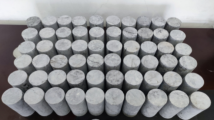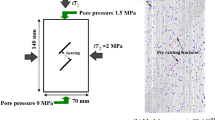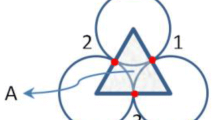Abstract
Discontinuities play a significant role in the analysis and design of rock structures, e.g., tunnels, stability of slopes, blocky rock masses, etc. Therefore, the following study is conducted using a discrete element method (DEM) model in Universal Distinct Element Code (UDEC) software which takes into consideration the discontinuities present in the material medium, both load-induced as well as inherent discontinuities. The DEM model in UDEC is used for the study to simulate the Uniaxial Compressive test response of Fresh Quartzite Rock. The Quartzite Rock is taken for this study because the same rock was encountered at a project site Saundatti, Karnataka, which has been identified as an amenable place to develop an integrated project by Greenko Group. In this study, all the laboratory experiments are performed on the Quartzite rock, and its behaviour is understood with those experimental results. Out of all the experiments, Uniaxial Compressive Strength (UCS) Test is chosen for the simulation purpose. The specimen model used for simulation of UCS is 110 mm in height and 54 mm in width. The specimen is further subdivided into around 900 smaller deformable blocks to simulate the field condition accurately. The model is bounded at the top and bottom by steel platens to ascertain relatively uniform load transfer across the specimen cross-section. The contact points between the deformable blocks are characterized with the normal and shear stiffness, with their nonlinear behaviour modelled from Mohr–Coulomb failure envelope (shear regime) and Rankine tension cutoff (tension regime). These micro-mechanical parameters to the DEM model are characterized by the obtained macro-level parameters from laboratory experiments. The simulation of UCS using UDEC is carried out to quantify the deformability characteristics, fracture patterns, and the stress–strain curve of the rock specimen. The deformability characteristics obtained from the numerical model are quite consistent with that of experimental observations and is mainly due to the precisely chosen micro-mechanical parameters. Moreover, the cracks initiation and propagation, stress profiles and deformation patterns obtained in the simulation are studied intricately.
Access provided by Autonomous University of Puebla. Download conference paper PDF
Similar content being viewed by others
Keywords
1 Introduction
Quartzite is a non-foliated metamorphic rock, an excellent medium for constructing dams and tunnels across the flowing stream of irrigation projects. Moreover, the rock is a naturally occurring geological material characterized by discontinuities in the form of joints, fissures, and inclusions. Therefore, representative design parameters of rock play a critical role in engineering design practices. In the past several decades, many research investigations have been undertaken to understand the fracture behaviour of rock specimens under various stress states. Many researchers have studied the deformation, peak and post-peak strength characteristics of rock specimens from their comprehensive experimental campaigns [1]. It should be mentioned that in the recent decades, there has been increased attention among the researchers on investigating the multi-scale behaviour of various rock specimen and the subsequent application in the performance-based design of engineered structures. Such studies are usually supported by physics-based numerical models, which account for the inherent as well as load-induced discontinuities along with relevant experimental studies [1].
Discontinuities play a vital role in the analysis of rock structures, especially for tunnels, caverns, blocky rock masses, slope stability problems, etc. Inherent discontinuities expected in rock masses (also referred to as joints, contacts) is a surface or plane that represents a change in the physical or chemical characteristics of a rock. The discontinuity can be in many forms, such as bedding, foliation, cleavage, crack, fissure, joint, or fault plane. These discontinuities affect the rock's response as they reduce its strength and induce nonlinearities in their deformation characteristics by altering the stress–strain response [2]. The other form of discontinuities expected in rock masses corresponds to load-induced discontinuities, which might result from various natural hazards (earthquakes, avalanches, etc.) It is to be noted that there are different techniques available to study such discontinuities [3,4,5], and notable mentions include traditional FEM, DEM, MPM, etc. Although conventional FEM has been well explored for solving various rock mechanics problems, they result in inaccurate model predictions, especially while handling discontinuities [6]. One potential alternative in this context includes the DEM, which has been utilized in the present study. In the case of DEM, complete detachment of particles is allowed and therefore, inherent discontinuities and load-induced discontinuities expected in rock masses can be modelled precisely.
The present study is conducted using a discrete element method (DEM) model in Universal Distinct Element Code (UDEC) software which takes into consideration the discontinuities expected in the material medium, both load-induced as well as inherent discontinuities. Different rock samples from the site were collected, and all the laboratory experiments were performed on the collected samples to characterize the Quartzite rock. The data collected from the laboratory experiments were used as input parameters in the numerical simulation. The Unconfined Compressive strength (UCS) test was chosen to carry out the numerical simulation, with emphasis on deformability characteristics, stress–strain response and fracture patterns, respectively.
2 Discrete Element Method
Discrete Element Method, also known as Distinct Element Method, is a discrete particle-based numerical technique and has been well explored for discontinuum simulations on rocky medium after it was first introduced by Cundall [7]. In the present study, a plane stress-based modelling strategy is chosen for the UCS test. The material medium in DEM is modelled as an assemblage of numerous small discrete semi-rigid 2-D polyhedral blocks. The mathematical foundations for such DEM framework can be seen in Cundall [7], and not repeated herein for the sake of brevity.
The blocks are connected to the neighbouring particles through contacts (See Fig. 1), and these contacts are treated as boundary conditions during the simulation. Moreover, the new contacts generated during the deformation are identified, and their forces and displacements are updated at each step. DEM allows translation motion and a rotational motion to the particles, which are again updated at each time step.
The assumptions pertaining to the present DEM framework is discussed herein. Firstly, the polyhedral blocks are semi-rigid with finite inertia (inertia of mass and rotation) and can be described analytically. The blocks can translate and rotate, and their interaction with neighbouring blocks will be governed by the contact algorithm. The interaction between the corners of a block is depicted by the contact behaviour, which is governed by the normal and shear contact springs and is assumed to be decoupled in the present study. The normal spring is assumed to be elastic in the compression regime, whereas in the tension regime, simple Rankine tension cutoff in normal tensile stress (σ) is considered and is mathematically written as
where, \({f}_{t}\) corresponds to the Rankine cutoff tensile strength. In the case of the shear regime, the failure envelope is governed by Mohr-Columb failure envelope (see Fig. 1) and is mathematically written as
where, \(\tau\), \(c\) and \(\varphi\) represent shear stress, cohesion and friction angle, respectively.
Blocks 1 and 2 represent the two semi-rigid connected by springs. The spring stiffness Kn and Ks acts in the normal and tangential direction, respectively. The friction coefficient µ represents the friction between the particles.
3 Sample Preparation and Testing
The rock samples were collected from the project site, Saundatti, Belagavi, Karnataka and the specimens were prepared as per the IS: 9179–1979 according to the requirement of the laboratory experiments. After the specimen preparation, laboratory experiments, namely: Bulk density test, Brazilian Test, Triaxial Compression and UCS test, were conducted. UCS of the Quartzite Rock was conducted to determine the peak strength, Modulus of Elasticity (E), and Poisson's ratio (µ). The parameters obtained during the UCS testing were later compared with the Numerical Results. Moreover, the fracture patterns obtained during the experiments were also compared with the fracture patterns obtained numerically during DEM simulations. The values obtained experimentally are shown in Table 1.
3.1 Uniaxial Compressive Strength
Uniaxial Compressive Strength (UCS) is performed in the laboratory to quantify the deformability characteristics of the rock. The deformability characteristics of the rock include Modulus of Elasticity, E and Poisson’s ratio, µ. The specimen with an L/D ratio of 2.0 is placed in the loading frame bounded at the top and bottom by steel platens. Four strain gauges, two vertical and two circumferential, are wound around the specimen, as shown in Fig. 2(a).
These strain gauges are further connected to the Wheatstone bridge circuit of the Multi-point Measuring Unit, as shown in Fig. 2(b). The axial, as well as lateral strains, are recorded from this unit. After the setup is ready, the specimen is loaded axially between the platens in the UTM, and the failure stress is recorded as the failure load per unit area of the cross-section of the specimen. The rate of loading should be such that the specimen fails in about 5 to 10 min. In other words, the stress rate should in the range of 0.5–1.0 MPa/s. In order to determine the deformability characteristics of the rock, the sample is not loaded to failure at once. It is performed in two cycles of loading and unloading. During the first cycle, the sample is loaded up to half of the expected UCS value and then unloaded to the initial or seating load. This is done in order to know the irrecoverable strain or permanent set of the specimen. The sample is loaded again, and the load is increased till the specimen fails. During the process of loading and unloading, the strains, both axial and lateral, are being recorded in the Measuring Unit at fixed intervals. These strains are used for plotting stress–strain curves and calculating the Modulus of Elasticity, E and Poisson's ratio, µ. These parameters are calculated at 50% of the UCS value and not up to the full UCS value.
4 Simulation Framework
For the previously discussed Quartzite sample, DEM analysis is performed in a plane-stress setting in UDEC. The principal reason for such an assumption is to facilitate computationally efficient numerical modelling, and such modelling strategies have been well established by earlier studies [6, 8]. The DEM model employs a two-level discretization strategy, as shown in Fig. 1, wherein the sample is discretized with 2-D polyhedral blocks, and the blocks are further discretized into zones. For the present simulation framework, the zones are assumed to be elastic, and a tension-shear mode of failure is considered at the contact points. Moreover, such nonlinear failure modes are characterized in an iterative manner from the obtained macro experimental properties discussed in the previous section.
4.1 Model Geometry
The Quartzite specimen used for the UCS experiment was 54 mm in diameter and 110 mm in height, as shown in Fig. 3. Using aforementioned sample dimensions, the 2-D DEM model (Sample dimensions: width = 54 mm; height = 110 mm) is created in a plane-stress setting as discussed previously. The specimen is bounded at the top and bottom by steel platens to ascertain uniform load distribution throughout the specimen, as shown in Fig. 3.
The height and width of the steel platen are 20 and 94 mm, respectively. The Quartzite model bounded between the steel platens is discretized into 900 polyhedral deformable blocks. Subsequently, each block is further discretized into three zones. The experimental UCS test for the chosen Quartzite specimen is strain-controlled. Accordingly, such physical boundary conditions are replicated in the numerical model by fixing the bottom platen and application of velocity of 0.05 mm/s at the top platen. The fracturing process is expected to take place along the contact points. The edge length of each deformable block is 2.55 mm. The chosen block sizes and the number of zones within each block are based on relevant convergence studies and not repeated herein for the sake of conciseness.
4.2 Input Parameters
For the developed DEM model, the input parameters are chosen in an iterative manner from the macro-level experimental observations. The summary of such macro-level experimental observations are shown in Table 1. The elastic properties (Modulus of elasticity (E), Modulus of rigidity (G) and Poisson's ratio) of the zones within the blocks are directly taken from the macro-level elastic properties of the sample. In the case of the contact points, the normal stiffness (Kn) and shear stiffness (Ks) are calculated using the empirical relation shown below, which is taken from the work of Prakash et al. [6] as
where, \({E}_{m}\) and \({G}_{m}\) represent the modulus of elasticity and shear modulus of the Quartzite sample obtained at the macro-level (see Table 1); \({t}_{b}\) represents edge length of blocks (2.55 mm in present DEM model). In scenarios where the modulus of elasticity departs from its experimental counterpart, the values obtained in Eqs. (3) and (4) are slightly adjusted for accurate model predictions. The values of \({f}_{t}\), c and \(\varphi\) required for the nonlinear contact behaviour in tension and shear regimes are taken from the macroscopic observations as depicted in Table 1. Upon building the DEM model, gravity analysis is first executed, followed by UCS test simulations, and the corresponding results are discussed in the subsequent sections.
5 Results and Discussions
Table 2 shows the comparison of the macro-level response entities, namely: modulus of elasticity (E), UCS and Poissons’s ratio against their experimental counterparts. The results indicate that the DEM based simulation framework is reasonably accurate in simulating the UCS test setup. The obtained stress–strain curve corresponding to the UCS test in the DEM simulation is depicted in Fig. 4. The stress–strain curve indicates elastic response followed by strain-softening as expected in quasi-brittle materials like Quartzite.
The fracture patterns obtained numerically as well as experimentally are presented in Fig. 5. However, it is observed that the obtained fracture patterns in DEM model are inconsistent with respect to its experimental counterpart. This limitation can be partly alleviated with more sophisticated contact models.
6 Conclusions
In the present study, experiments and numerical simulations were carried out on Quartzite Rock, and the following conclusions are drawn.
-
1.
The stress–strain curve obtained from the Numerical simulation was validated with the experimental results, and the values of deformability characteristics were compared. The UCS value of the rock obtained numerically was 55 MPa which was in close agreement with the experimental UCS value of 57.8 MPa. The Modulus of Elasticity and Poisson's ratio obtained numerically were also consistent with the experimental results. The Modulus of Elasticity, E and the Poisson's ratio, µ obtained numerically were 41.4 GPa and 0.25, respectively. These numerically obtained values were consistent with the experimental results, which produced E and Poisson's ratio of 41.5 GPa and 0.24, respectively.
-
2.
The Uniaxial Compressive Strength (UCS) test was conducted on Quartzite Rock and the crack patterns developed in the specimen during the loading was observed. The crack patterns obtained in the specimen model during the numerical simulation was also observed and compared with those obtained in the laboratory during the experiments. The cracks obtained numerically followed more or less the same patterns as were obtained experimentally.
-
3.
It is sometimes challenging to measure the stress and displacement fields inside a rock specimen during laboratory experiments. These stress and displacement fields play a very vital role in understanding the fracture mechanisms occurring inside the rock. Therefore, in order to gather such information related to fracture mechanisms, numerical techniques like Discrete Element Method (DEM) are adopted which can simulate the field conditions of the rock when they are subjected to different kinds of loading.
References
Zhao C, Niu J, Zhang Q, Yu S, Morita C (2019) Numerical simulations on cracking behavior of rock-like specimens with single flaws under conditions of uniaxial and biaxial compressions. J Mater Civ Eng 31:04019305. https://doi.org/10.1061/(asce)mt.1943-5533.0002967
Lisjak A, Grasselli G (2014) A review of discrete modeling techniques for fracturing processes in discontinuous rock masses. J. Rock Mech Geotech Eng 6:301–314. https://doi.org/10.1016/j.jrmge.2013.12.007
Zhang XP, Wong LNY (2012) Cracking processes in rock-like material containing a single flaw under uniaxial compression: a numerical study based on parallel bonded-particle model approach. Rock Mech Rock Eng 45:711–737. https://doi.org/10.1007/s00603-011-0176-z
Tang CA, Lin P, Wong RHC, Chau KT (2001) Analysis of crack coalescence in rock-like materials containing three flaws - Part II: numerical approach. Int J Rock Mech Min Sci 38:925–939. https://doi.org/10.1016/S1365-1609(01)00065-X
Hoek E, Martin CD (2014) Fracture initiation and propagation in intact rock - a review. J Rock Mech Geotech Eng 6:287–300. https://doi.org/10.1016/j.jrmge.2014.06.001
Prakash PR, Pulatsu B, Lourenço PB, Azenha M, Pereira JM (2020) A meso-scale discrete element method framework to simulate thermo-mechanical failure of concrete subjected to elevated temperatures. Eng Fract Mech 239:107269. https://doi.org/10.1016/j.engfracmech.2020.107269
Cundall AP (1971) A computer model for simulating progressive, large-scale movement in blocky rock system. In: Proceedings of the international symposium on rock mechanics 1971 (1971)
Kazerani T, Zhao J (2010) Micromechanical parameters in bonded particle method for modelling of brittle material failure. Int J Numer. Anal Methods Geomech 34:1877–1895. https://doi.org/10.1002/nag.884
Acknowledgements
This research work was supported by Civil Engineering Department of National Institute of Technology, Warangal, India. The authors would also like to express their sincere gratitude to the editor and anonymous reviewers for their valuable comments, which have greatly improved this paper.
Author information
Authors and Affiliations
Corresponding author
Editor information
Editors and Affiliations
Rights and permissions
Copyright information
© 2022 The Author(s), under exclusive license to Springer Nature Singapore Pte Ltd.
About this paper
Cite this paper
Ramana, G.V., Verma, J., Ravi Prakash, P. (2022). Testing and Numerical Simulations on Fracture Behavior of Fresh Quartzite Rock Using the Discrete Element Method. In: Tadepalli, T., Narayanamurthy, V. (eds) Recent Advances in Applied Mechanics. Lecture Notes in Mechanical Engineering. Springer, Singapore. https://doi.org/10.1007/978-981-16-9539-1_13
Download citation
DOI: https://doi.org/10.1007/978-981-16-9539-1_13
Published:
Publisher Name: Springer, Singapore
Print ISBN: 978-981-16-9538-4
Online ISBN: 978-981-16-9539-1
eBook Packages: EngineeringEngineering (R0)









